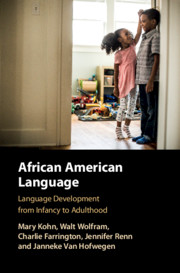Book contents
- African American Language
- African American Language
- Copyright page
- Contents
- Figures
- Tables
- Preface
- Abbreviations
- 1 Coming of Age in African American Language
- 2 The Analysis of Sociolinguistic Change over the Lifespan
- 3 Profiles of Change
- 4 Vowel Variation across Time and Space
- 5 Caretaker’s Influence on Vernacularity
- 6 The Influence of Peers on the Use of African American Language
- 7 Stylistic Variation in the Early AAL Lifespan
- 8 The Relationship of African American Language and Early Literacy Skills
- 9 A Longitudinal Study in Retrospect
- Appendix AAL Feature Code Key
- Index
- References
5 - Caretaker’s Influence on Vernacularity
Published online by Cambridge University Press: 24 November 2020
- African American Language
- African American Language
- Copyright page
- Contents
- Figures
- Tables
- Preface
- Abbreviations
- 1 Coming of Age in African American Language
- 2 The Analysis of Sociolinguistic Change over the Lifespan
- 3 Profiles of Change
- 4 Vowel Variation across Time and Space
- 5 Caretaker’s Influence on Vernacularity
- 6 The Influence of Peers on the Use of African American Language
- 7 Stylistic Variation in the Early AAL Lifespan
- 8 The Relationship of African American Language and Early Literacy Skills
- 9 A Longitudinal Study in Retrospect
- Appendix AAL Feature Code Key
- Index
- References
Summary
In this chapter, we examine the relationship between the vernacularity of caretaker speech as represented by the participants’ mothers and the subjects in the FPG sample. In this chapter, we examine the relationship between the vernacularity of caretaker speech as represented by the participants’ mothers and the subjects in the FPG sample. The analysis indicates that a significant relationship between the relative vernacularity of AAL-speaking mothers and their children exists across most of the early lifespan. Further, the analysis of the impact of relevant social and family factors on the development of AAL vernacularity reveals gender as a significant determiner at only the earliest and the latest points in the early lifespan. Finally, the analysis uncovers the nuanced picture of the relationship between mothers’ and children’s vernacularity – that adolescent females from low-vernacular families are likely to become low-vernacular speakers (like their mothers) in older adolescence. Finally, we see the departure of the children from the parents in the early stages of schooling, following the roller coaster trajectory described in the overall trajectory of vernacularity described for morphosyntactic features.
Keywords
- Type
- Chapter
- Information
- African American LanguageLanguage development from Infancy to Adulthood, pp. 111 - 134Publisher: Cambridge University PressPrint publication year: 2020

